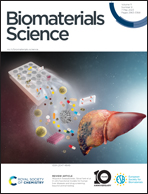Self-assembled thioether-bridged paclitaxel-dihydroartemisinin prodrug for amplified antitumor efficacy-based cancer ferroptotic-chemotherapy†
Abstract
Ferroptosis has been proposed as one form of iron-dependent cell death, overgeneration of high-toxicity hydroxyl radicals (˙OH) tumor sites via Fenton reactions induced cell membrane damage. However, the insufficient intracellular concentrations of both iron and H2O2 limited the anticancer performance of ferroptosis. In this study, ROS-sensitive prodrug nanoassemblies composed of a PEG2000-ferrous compound and a single thioether bond bridged dihydroartemisinin-paclitaxel prodrug were constructed, which fully tapped ex/endogenous iron, ferroptosis inducers, and chemotherapeutic agents. Following cellular uptake, the intracellular oxidizing environment accelerated the self-destruction of nanoassemblies and triggered drug release. In addition to the chemotherapeutic effect, the activated dihydroartemisinin was capable of acting as a toxic ˙OH amplifier via the reinforced Fenton reaction, simultaneously depleting intracellular GSH, as well as inducing glutathione peroxidase 4 inactivation, further enhancing ferroptosis-dependent cancer cell proliferation inhibition. Meanwhile, the ROS generation-inductive and cell cycle arrest effect from the paclitaxel augmented synergetic ferroptotic-chemotherapy of cancer. Thus, the prodrug integrating dihydroartemisinin with paclitaxel via a single thioether bond represents a potent nanoplatform to exert amplified ferroptotic-chemotherapy for improved anticancer efficacy.



 Please wait while we load your content...
Please wait while we load your content...